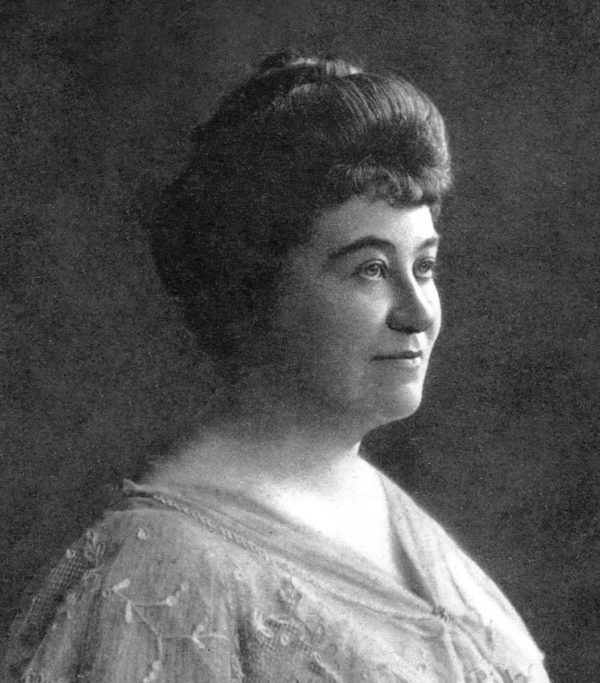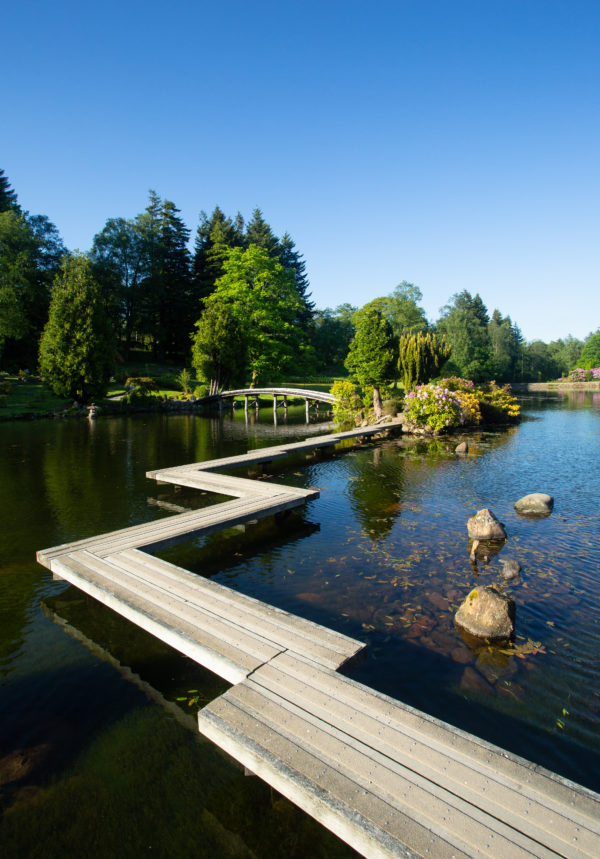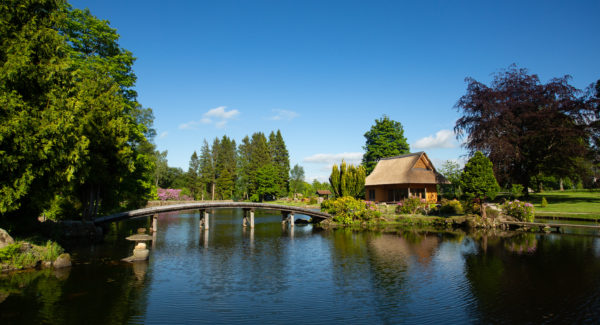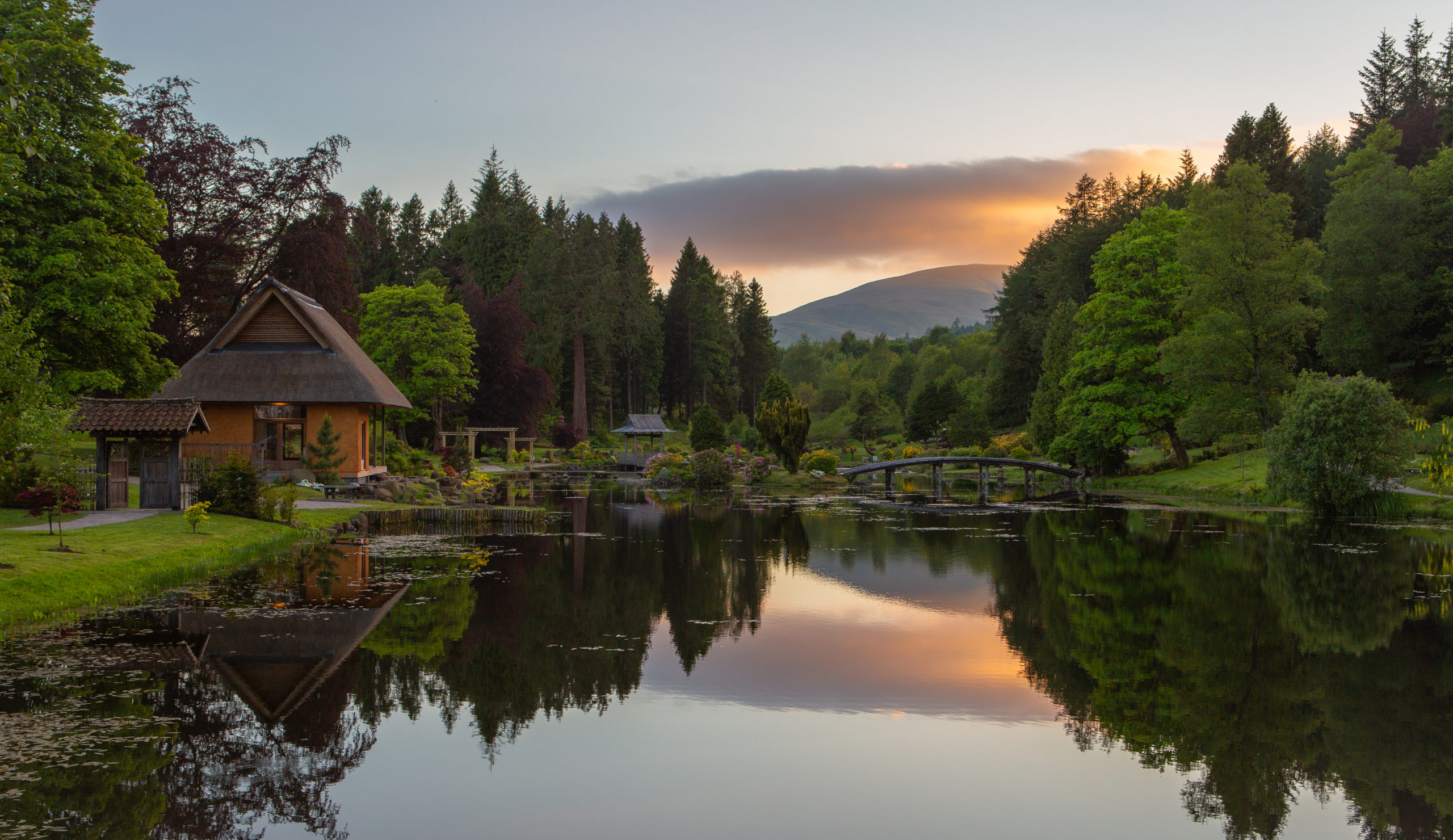By: Judy Vickers
Everything about the Japanese Garden at Cowden is designed to slow visitors down, to calm the mind and encourage contemplation, even down to the uneven stones underfoot at the entrance arch, which is carved with the words “the place of pleasure and delight”. These days, the garden, near the town of Dollar, quietly hums with tranquillity and serenity – yet its history is filled with turbulence and drama. Created by one of the most extraordinary and pioneering Scottish women of the 20th century, it has survived destruction at the hands of vandals and abandonment for more than 50 years to become restored to its former glory by one of her descendants.
This summer the final touches to the restoration of the main garden will be put into place, including a wooden sunshade, which is currently under construction. It will mark more than a decade of work by Sara Stewart, great niece of the garden’s creator Ella Christie, who inherited the estate in 2012. “I had Ella on my shoulders,” she has said of creating the plans to revitalise the 2.8-hectare site. And Ella Christie would be quite a formidable, if inspiring, character to have watching over you.
Cowden Castle and Estate

Ella’s father, John, had made his money in coal in Lanarkshire and to seal his entry into the landed gentry, bought a big pile – Cowden Castle and Estate – in 1865. Four-year-old Ella moved there with her mother, brother and sister and grew up on the estate which had once belonged to the bishops of St Andrews. As a family they were fond of travel and Ella had already visited much of Europe by the time her mother died in 1894. Her brother had died at 12 and her sister, Alice, was married so she became her father’s travelling companion and the pair ventured further afield to Egypt, Palestine and Syria.
But this exciting lifestyle came to an abrupt end in 1902 when her father died. Lindsey Gibb, a Perthshire storyteller who was commissioned last year by Year of Storytelling funds to uncover more details about Ella’s extraordinary life, explains: “Ella was very much with her father a lot of the time but the day after he died there was a knock on the door. I always picture the man standing there in a trench coat with a clipboard. They [Ella and sister Alice] discovered only then that all their father’s money had been willed away from them and given to a charity that he had set up without them knowing. Alice was married and married well but Ella was left destitute. She had no money of her own and no home, overnight she had lost everything.”
There had been no sign of the rift between father and daughters before his death but Lindsey says: “He had had an illness before he died and his personality had changed,” and points to the possibility of some form of dementia. But even as the man from the charity left the shell-shocked daughters at the doorstep and proceeded to tour the house, cataloguing the furniture and family’s possessions as he went, Ella was forming a plan. “Ella, being Ella, doesn’t take this lying down,” says Lindsey. “She fights it in court and she wins a healthy settlement, the equivalent of several million pounds today and she manages to keep the estate and castle. The orphanage charity which her father had set up was also well provided for. Ella and her sister were very charitable themselves, so it must have been difficult for her to fight it.”
The most important Japanese garden in the Western world

With her future secure, Ella now embarked on her overriding passion in life – travel. With her trusty maid Humphries, she made journeys that few single Western women had even dreamt of in the early years of the 20th century, through India, Kashmir, Ceylon, Malaya and Borneo. She banqueted with the Maharaja of Kashmir, camped in snow in the Chorbat Pass in Pakistan, trekked on foot for 60 miles in the Desoi mountains in the Himalayas and became the first Western woman to meet the Dalai Lama.
“She must have been incredibly charming, people just open doors for her left, right and centre,” says Lindsey. But it was when, after travelling through Korea, she took a boat to Japan, that another passion was ignited. “She just falls in love with the gardens in Japan – and handily she has an estate back home where she can recreate one,” says Lindsey.
That 1907 tip to Kyoto and beyond inspired her so much that when she returned to Scotland, she hired Taki Handi, a female Japanese garden designer, from the Royal School of Garden Design at Nagoya, but at that time studying at Studley College in England to create her Shã Raku En – the place of pleasure and delight. “She [Taki] became the first woman to create a Japanese garden outside of Japan and even in Japan it was rare,” says Lindsey.
She did an impressive job, melding views of the nearby Ochils Hills into the lines of the garden and using local plants as well as imported Japanese specimens and those grown from seeds Ella had snaffled while in Japan. “The garden was created on a marshy bit of the estate, they dammed a burn to create a loch because water is a big part of Japanese gardens,” says Lindsey. A tea house, lanterns and bridges completed the site which so faithfully reproduced the exquisite gardens which had inspired Ella in Japan, that in 1925, Professor Jiji Suzuki, the 18th hereditary head of the Soami School of Imperial Design in Japan, called it the most important Japanese garden in the Western world.
He was a regular visitor, helping to maintain the trees and bushes, and from 1925, the garden was looked after full time by expert Japanese gardener Shinzaburo Matsuo who had lost his entire family in an earthquake in Japan. He found a new home in Scotland and he and Ella had long conversations about gardening plans – despite the fact he spoke no English and Japanese was not one of the four languages Ella was fluent in.
And for Ella it was indeed a place of pleasure and delight, where she held tea parties with her friends as she recharged from her latest travels – she continued to journey until a few months before her death from leukaemia in 1949. By then she was living in just a few rooms of the castle, crammed in with treasures from her globe-trotting.
Lives up to its name

After her death, the estate was inherited by her nephew, Robert Stewart, Alice’s son. The castle, Lindsey believes, must have been in a poor state, as attempts to sell it failed and it was completely demolished in the 1950s. The Japanese Garden remained however until 1963 when it was destroyed in a vandal attack by local schoolboys. “It was absolutely devastated, they burned everything that could be burned and destroyed everything that could be destroyed,” says Lindsey. “They never caught who did it even though they were seen leaving in their school uniforms. No one has ever been caught and no one has ever come forward as they got older to admit it, we don’t know if it was teenage high jinks or if there was something more behind it.”
Too expensive to repair, the garden was then left to slowly decay and become overgrown until 2012 when an ageing Robert passed the garden to his daughter, Sara. She began a fundraising campaign and created a trust to restore the garden to Ella’s vision. Helped by £750,000 from the UK government, funds from other sources and expert advice from Professor Masao Fukuhara, best known for restoring the Japanese Gardens at Kew in London, the garden was slowly revived.
Now reopened to the public, the garden is once again welcoming visitors from near and far, just as Ella planned. Lindsey says: “It’s wonderful to walk around the corner and find a Japanese garden in this rural part of Scotland – it blends so well with the landscape. I find I instinctively relax as I go through that archway, you get away from all the busy-ness of life. It lives up to its name, it is a pleasure and a delight.”
For more information see: www.cowdengarden.com
Main photo: Japanese Garden at Cowden. Photo: Tom Langlands Photography.

